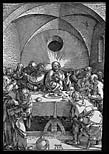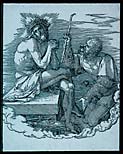The St. Matthew Passion - The Jewel of the Genre by Dr. Lisette Canton
/ April 1, 2002
Version française...
Among the unpublished scores listed in the
catalogue of Bach's works, and included in his 1754 obituary, are "five
Passions, of which one is for double chorus." This work, presumably the St. Matthew Passion – referred to as "the great
Passion" in the Bach family circle – was composed in 1727, between the more
modestly scored St. John Passion of 1724 and the St. Mark Passion of 1731. The differences between these
three Leipzig Passions (the other two are presumably lost) are seen in their
overall form, layout, scoring and conception. Of the three works, the St. John Passion lacks textual unity because of
madrigal lyrics that were compiled from various poetic sources. Bach thus began
to look for a different kind of text and eventually came into contact with
Picander (Christian Friedrich Henrici), a poet responsible for a large number of
occasional sacred texts, many of which Bach used in his cantatas. With its
mixture of Gospel text and complex madrigal-style poetry, Picander's St. Matthew Passion libretto constituted, from a
literary point of view, a unified Passion oratorio which enabled Bach to compose
a wholly original work in a single sweep.
A long history
 The Passion as a
genre has a long history, dating back to medieval times, but from the beginning
of the sixteenth century onwards three types may be distinguished according to
text: those setting the complete text according to one Evangelist; the so-called
summa Passionis (Passion harmony), made up of
sections taken from all four Gospels, including all seven words of Christ on the
cross; and the setting of a shortened version of the text of one Gospel (found
only in Protestant Germany). In its desire to encourage liturgical singing in
the vernacular, the Lutheran church made a considerable contribution to the
growth and dissemination of this genre. In Leipzig, for example, there had been
a tradition, dating back to 1669, of reciting the texts of the Passion choraliter (a style of singing derived from Gregorian
chant) on Palm Sunday, when St. Matthew's Gospel was used, and on Good Friday,
when St. John's Gospel was preferred. From 1717 onwards, the polyphonic style
(figuraliter) was authorized for the performance of
both Passions; and from Good Friday 1721 it became traditional to perform a
polyphonic Passion either at St. Thomas's Church, where Bach had been kapellmeister since 1723, or at St.
Nicolas's.
The Passion as a
genre has a long history, dating back to medieval times, but from the beginning
of the sixteenth century onwards three types may be distinguished according to
text: those setting the complete text according to one Evangelist; the so-called
summa Passionis (Passion harmony), made up of
sections taken from all four Gospels, including all seven words of Christ on the
cross; and the setting of a shortened version of the text of one Gospel (found
only in Protestant Germany). In its desire to encourage liturgical singing in
the vernacular, the Lutheran church made a considerable contribution to the
growth and dissemination of this genre. In Leipzig, for example, there had been
a tradition, dating back to 1669, of reciting the texts of the Passion choraliter (a style of singing derived from Gregorian
chant) on Palm Sunday, when St. Matthew's Gospel was used, and on Good Friday,
when St. John's Gospel was preferred. From 1717 onwards, the polyphonic style
(figuraliter) was authorized for the performance of
both Passions; and from Good Friday 1721 it became traditional to perform a
polyphonic Passion either at St. Thomas's Church, where Bach had been kapellmeister since 1723, or at St.
Nicolas's.
After its first
performance on April 11, 1727, Bach revised the St.
Matthew Passion only once, extending and refocusing its musical dimensions
while leaving the overall design and libretto intact. In 1736, on the occasion
of its third performance, Bach replaced the simple chorale, Jesum lass ich nicht von mir, which originally
concluded part I, with the massive chorale fantasia, O
Mensch, bewein dein Sünde groß, taken from the second version of the St. John Passion. He also made a more decisive division
of the entire ensemble into two vocal-instrumental bodies by assigning separate
continuo groups to choirs I and II. In addition, he used the swallow's nest
organ and choir loft at St. Thomas's in the performance by assigning the cantus
firmus lines of the two choruses that framed part I (nos. 1 and 29) to a third
choir made up of sopranos with organ support (marked Soprano in ripieno in the score). The definitive
character of the 1736 revisions is expressed by the calligraphic autograph copy
that he completed with great scrupulousness. It is clear that Bach considered
this score as his most significant work up to that point.
Based on a reprint
of the text in volume ii of Picander's collected works published in 1729, the
biblical Passion narrative may be divided into fifteen scenes and two
introductions, to which both the lyrical meditations and the interspersing of
hymn stanzas relate. All of the lyrics are introduced by biblical references so
that the function of every single poem and musical setting becomes
clear.
All musical means
 A distinctive
feature of the St. Matthew Passion is Bach's optimal
use of all musical means available to him, including widely diverse singing
voices and instrumental sonorities (exclusive of brass). He also drew on the
complete repertoire of forms in sacred and secular music.
A distinctive
feature of the St. Matthew Passion is Bach's optimal
use of all musical means available to him, including widely diverse singing
voices and instrumental sonorities (exclusive of brass). He also drew on the
complete repertoire of forms in sacred and secular music.
The "great
Passion" begins with a large-scale chorale fantasia for double chorus, each
choir with its own orchestral support, with a seamless integration of freely
conceived verse and chorale text and melody. At bar 30 this chorale, O Lamm Gottes, unschuldig (O innocent lamb of God),
which serves as the cantus firmus, soars above the choral and orchestral texture
and immediately responds to the dialogue Seht ihn! Wie?
Als wie ein Lamm! (See him! How? Just as a lamb!). The text of the chorale
is the metrical paraphrase of the Agnus Dei which
would have been sung at the end of the morning service on Good Friday. The
opening chorus thus provides a summation of what the entire Passion oratorio
aims to achieve in theological content, literary structure, and musical
expression.
The progression
through the details of the Passion story is frequently presented in a repeated
pattern of biblical narrative, comment, and prayer. The biblical narrative is
sung mainly by the Evangelist, but with various dramatic roles represented by
other voices, and groups of people by choir I or II (or both) of the choruses.
Next, before the narrative is continued, a recitative comments on the biblical
narrative just heard, and the substance of the comment is transformed into a
prayer in an aria that follows. A final element in the varied texture of the
Passion lies in the chorales that punctuate the narrative.
Individual styles
Each character
also has his or her particular musical style and function in the Passion. The
Evangelist carries the actions forward in the form of recitativo secco, accompanied by continuo alone, merely
recounting events. Jesus speaks to his disciples and to Pilate in the form of an
arioso halfway between recitative and aria. Except at the very end, he is
accompanied by strings in addition to the continuo, which create a symbolic
"halo" around his words. Only in the passage preceding his death (no. 61: Eli, lama asabthani) is this effect abandoned and recitativo secco restored.
The St. Matthew Passion is symmetrically structured around
a central point which occurs between the two turba
choruses, nos. 45a and 50a, Laß ihn kreuzigen
(Crucify Him) while Christ appears before Pilate. It is during the soprano
aria (no. 49), Aus Liebe will mein Heiland sterben
(For love my Saviour now is dying), that the whole meaning behind Christ's
Passion is revealed.
In terms of
harmonic texture and colour, Bach employs the widest possible range of musical
expression. The St. Matthew Passion strides moves
through a variety of keys while drawing on an extraordinary array of colours in
the instrumental obbligato accompaniments of the arias. Bach takes the harmony
to its furtherest extreme in no. 59, Ach Golgotha
(which uses all twelve chromatic pitches), and on Jesus's last words Eli, lama asabthani which appears in b-flat minor and
moves to e-flat minor in the subsequent translation. His key choices for the
"Passion chorale" – the melody of Herzlich tut mich
verlangen – which appears five times in nos. 15, 17, 44, 54, and 62, follow
a reverse tonal descent through the successive key signatures
( 4 sharps / 3
flats / 2 sharps / 1 flat / natural),
and illustrates
the path of inevitability as the Passion progresses.
The St. Matthew Passion represents the culmination of not
only the Lutheran tradition of liturgical Passions, but of the entire genre as
well. It is a work of majesty which demonstrates the height of Bach's
compositional mastery as well as the profundity of his musical expression and
his understanding of the liturgical and spiritual elements of his faith. After
some 275 years since its first performance, the St.
Matthew Passion remains the summit of the choral art alongside the Mass in B minor.
Dr. Lisette Canton conducts the Ottawa Bach Choir, the
Carleton University Choir and teaches choral conducting and aural training. She
is also the Director of Music at Rideau Park United Church and a vocal coach,
choral workshop leader, adjudicator, and guest conductor. Dr. Canton just
conducted a very successful performance of the St. Matthew Passion on March 10 in Ottawa.
The complete St. Matthew Passion will be performed by the St. Lawrence Choir in Montreal
directed by Iwan Edwards on April 14 in two sessions. The concert is a
celebration of the 30th anniversary of the choir. (514) 790-1245.
Version française... |
|


